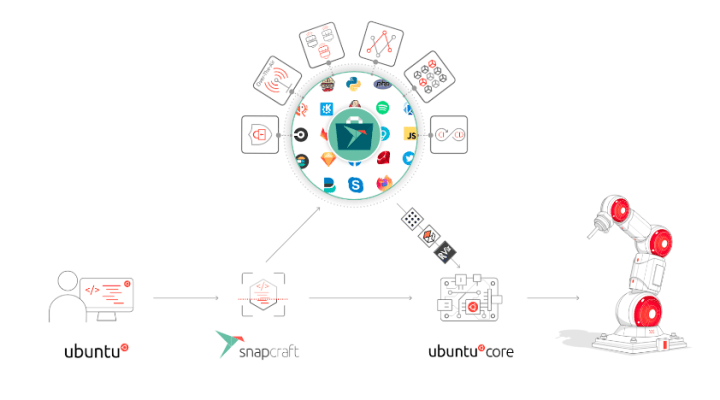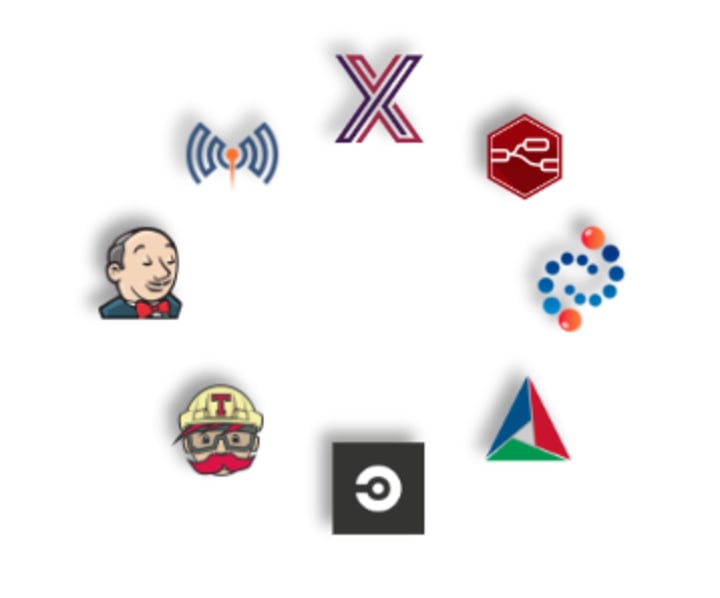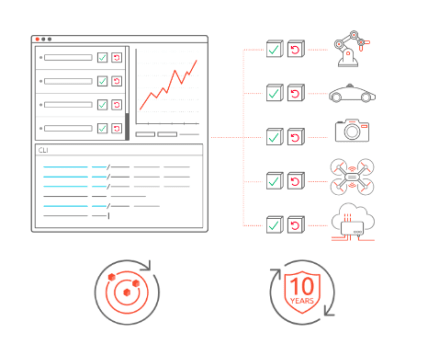Edoardo Barbieri
on 4 November 2022
Accelerate IT / OT convergence in Industry 4.0 [Part III]
Welcome to the concluding blog of this mini-series on tapping into the fourth industrial revolution.

In Part I, we introduced and assessed the current status in the IT and OT domains. In Part II, we discussed the automation pyramid of modern factories and the need to adopt a more holistic approach toward closing the divide. In the final chapter of this three-part blog series, we will make a case for how adopting an enabling, open-source platform can help bridge the IT/OT divide and accelerate industrial transformation.
Ubuntu is the preferred operating system and an ideal enablement platform to bring the latest technological advances to the OT world. As the most widely used Linux distribution globally, the most deployed Linux web server on the internet and the most used Linux gaming distro, Ubuntu is the de-facto Linux standard in IT. After recognising and acknowledging the new wave of compute in Industrial, we created a flavour of Ubuntu to address the limitations of the OT world highlighted in Part I and Part II of this series.

Ubuntu Core, the embedded version of Ubuntu, is an OS designed for Industry 4.0 that can be used on devices on the shop floor to bridge the gap between OT and IT. Ubuntu Core provides a production-grade platform for Industry 4.0 integration, and secure, open-source development and deployment. As an open-source, underlying base that can work across different verticals, Ubuntu Core enables device manufacturers to capitalise on the wave of tightly embedded, connected devices.
As an enabling platform, Ubuntu Core and its surrounding ecosystem aim to focus on the fundamental challenges faced by enterprises and remove the blockers to IT/OT convergence. In the remainder of this blog, we will assess three pillars to deliver the flexibility, portability and scalability that end customers desire.
Portability and scalability for Industry 4.0
One of the limitations of the OT world is its legacy machinery. In Part I, we discussed how the legacy infrastructure of the OT world poses barriers to data sharing and 2-way communication between devices. Industrial manufacturers struggle to scale, as the intelligence of a device is hardware-bound even when sitting in software. Every device – whether a PLC, gateway or robotic controller – has one function not portable across form factors. Furthermore, there is no central point for administering or managing PLCs and field devices, and industrial manufacturers need to USB-connect to the shop floor for updates or directly upgrade the hardware in case of malfunction.

Ubuntu Core accelerates industrial transformation by enabling every device to be software-defined. It is an OS built from snaps, a new application packaging format that uses container technology. Snaps work anywhere, including all major Linux distributions, and are suitable for any class of devices, from desktop to cloud and IoT. As cross-platform, containerised software packages, snaps bundle applications with their dependencies. The scalability of snaps is a sharp improvement on the lack of standardisation and portability in OT. Snaps are portable across form factors, removing software boundaries between platforms.
Unlock digital transformation in Industry 4.0
The legacy machinery from the OT world can now be software-defined. Every industrial device running Ubuntu Core can run apps: its primary function is an app, and developers can ship other functionalities next to that. Industrial manufacturers can now have a single, software-defined controller with a PLC app, a motion app, a runtime app and a communication app, all in a sandboxed environment. Ubuntu Core enables the transition from being hardware-bound to being hardware-agnostic, with multiple functionalities in separate containers.
Furthermore, device manufacturers can update applications independently of the OS because Ubuntu Core cleanly decouples the base system from the installed applications. Also, Ubuntu Core and the snap technology allow the development of industrial apps with the same ease found in the IT and mobile world. When working on a mobile app, developers don’t have to think about the low-level details and underlying processors. In the same vein, snaps abstract that complexity, bringing the same technologies that have proven successful in the IT world to the world of OT.
The application-centric nature of Ubuntu Core goes beyond snaps. Industrial manufacturers have access to a ready-to-use, plug-and-play solution to unlock their digital transformation. Each device running Ubuntu Core further has an application store, hosting thousands of apps, whether public, published by the community, or private to the vendor. Industrial manufacturers can thus leverage a production-grade infrastructure to build their industrial device or gateway. The Store supports the top industrial protocols as snaps, whether OPC-UA or MQTT clients. Device manufacturers can easily send data to their preferred platform, like AWS Greengrass.

Furthermore, developers can extend the functionality of their OT hardware with AI/ML apps for production and process improvement with any language or toolchain. The flexibility provided by the App Stores enables industrial manufacturers to plan for shifting needs, maximising utilisation and reducing the total cost of ownership of their software-defined assets.
Secure and up-to-date Industrial devices
A recurring theme in Part I and Part II of this mini-series was the lack of security in the OT world. It is of utmost importance to bring the same security level found in desktops, servers and cloud down to devices in the field.
The ecosystem around Ubuntu Core is end-to-end secure, starting with bug fixes and CVE patches to the OS via robust updates. Over-the-air updates, widely accessible in the IT world, are now available in OT too. Ubuntu Core installs automated and transactional updates only if successful, making updating software on industrial devices worry-free. Expensive downtime in the production line is now part of the past. Industrial manufacturers don’t have to worry about sending expensive engineers to the field to manually fix their broken devices as Ubuntu Core has built-in automatic recovery mechanisms. Every update preserves the previous version of code and data, so app developers can safely move them forwards and backwards in their version history. If an error occurs due to poor connectivity in remote locations, the update will stop and revert to the previous working version of the application. Furthermore, the system will automatically calculate the binary delta to minimise the traffic and time required to distribute that update and preserve bandwidth.

Ubuntu Core does not limit its security to the OS and update mechanism.
Snaps are a secure environment where industrial manufacturers can run their applications. Leveraging confinement, the application on an industrial gateway will not access the security camera unless permitted.
Security is at all levels of the ecosystem, including the reliable communication between devices and the Store for permission management or authentication. Furthermore, the minimal OS, the kernel, and device drivers are also packaged and installed as snaps, so all the benefits that apply to applications also apply to the system foundation.
Long-term maintenance for Industry 4.0
Ubuntu Core distributes robust updates to devices in the field throughout their long life. Ubuntu Core provides long-term service availability for devices requiring low-touch, remote maintenance. Manufacturers don’t receive just remote, unattended updates, but also that an OS managed for 10 years. With a decade of secure updates, industrial devices are now as secure as servers. Enterprises can now concentrate their efforts, explore new business models and redirect resources toward value-add activities.
Conclusion
Industrial manufacturers attempted to tap into the fourth industrial revolution by funding AI/ML and digitalisation projects. Siloed solutions fell short of their promises as enterprises did not address the fundamentals but only focused on applying the latest technologies. Legacy install bases and a lack of standardisation prevented industrial transformation from occurring. To fully reap the benefits of Industry 4.0, the industrial factory has to close the gaps between OT and IT. The convergence between the two domains calls for a transition from legacy stacks with closed standards and interfaces to modern IT solutions and the embrace of open-source software.
With Ubuntu Core and its surrounding ecosystem, industrial pioneers have access to a secure, containerised, and ready-to-go platform to jump-start their Industry 4.0 journey. Ubuntu Core bridges the gap between OT and IT by bringing the same level of security, long-term maintenance, OTA updates and interoperability across form factors to all the levels of the industrial factory. From the desktop to servers, clouds and embedded devices, Ubuntu Core removes the fragmentation and provides the same consistent and secure user experience across the entire compute spectrum.

Interested in accelerating your industrial transformation and seizing market opportunity? Join our on-demand webinar on how to tap into the fourth industrial revolution.
Further reading
Join the conversation on IoT Discourse to discuss everything related to IoT and tightly connected, embedded devices.
Why is Linux the OS of choice for IoT devices? Find out with the official guide to Linux for embedded applications.
Working on a new IoT project, but unsure which OS to pick? Learn about the trade-offs between Yocto and Ubuntu Core.
Did you hear the news? Real-time Ubuntu 22.04 LTS Ubuntu is now available. Check out the latest webinar on real-time Linux to find out more.



